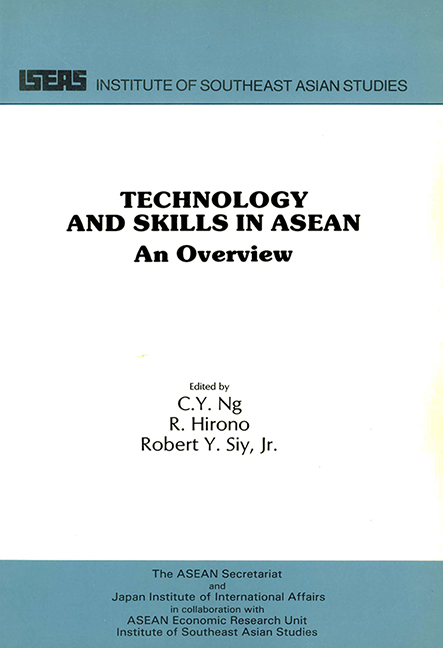Book contents
- Frontmatter
- Contents
- Foreword
- Preface
- PART ONE ASEAN OVERVIEW
- Introduction
- 1 Industrialization in ASEAN
- 2 Technology Transfer, Adaptation and Diffusion in Asean: Problems and Issues
- 3 Science and Technology Policies in Asean
- 4 The Experience From Selected Asean Industries
- 5 Conclusions and Recommendations
- PART TWO SECTION 1: JAPANESE OVERVIEW
- PART TWO SECTION 2: JAPANESE EXPERIENCES IN TECHNOLOGY TRANSFER
- The Editors
1 - Industrialization in ASEAN
from PART ONE - ASEAN OVERVIEW
Published online by Cambridge University Press: 09 November 2017
- Frontmatter
- Contents
- Foreword
- Preface
- PART ONE ASEAN OVERVIEW
- Introduction
- 1 Industrialization in ASEAN
- 2 Technology Transfer, Adaptation and Diffusion in Asean: Problems and Issues
- 3 Science and Technology Policies in Asean
- 4 The Experience From Selected Asean Industries
- 5 Conclusions and Recommendations
- PART TWO SECTION 1: JAPANESE OVERVIEW
- PART TWO SECTION 2: JAPANESE EXPERIENCES IN TECHNOLOGY TRANSFER
- The Editors
Summary
The analysis of the process of technology transfer must be done within the larger context of a particular country's economic development. Given the pervasive economic interdependency between countries at different stages of development, attention must be directed to the impact of these evolving relationships on the process of technology transfer. In this study, therefore, the process of technology transfer is discussed as a key aspect of the process of industrialization, which is now developing rapidly in ASEAN, and also, within the larger context of growing interdependence between ASEAN and Japan.
Past Trends and Patterns
In recent history, the ASEAN region has stood out as a centre of economic growth. From 1971–82, the five original member countries experienced average rates of real GDP (gross domestic product) growth ranging from 5.7 to 9.0 per cent, an outstanding record by any comparison with the developed countries during the same period (Table 1).
The average growth rates of the industrial sector in the ASEAN countries during the period 1971–82 were even higher, ranging from 7.6 to 11.9 per cent (Table 2). From 1975 to 1980, the share of industry in the GDP of ASEAN also increased dramatically (Table 3). This indicated the substantial contribution of industry, particularly manufacturing, to the overall progress of the ASEAN economies. It should also be noted that these advancements were achieved in spite of the instability in the world economy during this period, brought about by such events as the oil price increases in 1973–74 and in 1979–80 and the recession that followed in many industrialized countries.
The economic performance of the region was truly remarkable in view of the marked differences in the culture, endowments, characteristics, and industrial policies of the five countries. Singapore and Indonesia stand in extreme contrast to each other. One possesses a small, relatively skilled population with few natural resources. The other is equipped with vast natural resources, a large domestic market, and an agriculture-based population. Malaysia, the Philippines and Thailand are between the two extremes, with strong dependence on exports of primary commodities but respectable efforts at developing light manufacturing industries.
- Type
- Chapter
- Information
- Technology and Skills in ASEANAn Overview, pp. 7 - 18Publisher: ISEAS–Yusof Ishak InstitutePrint publication year: 1988

